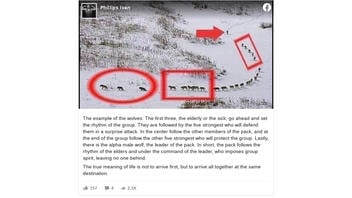
Does this caption accurately describe the social structure of a wolf pack that happened to be photographed moving single file through the snow? No, that's not true: This is an allegorical caption that uses the image of a wolf pack to deliver a lesson to people about "the true meaning of life." This breakdown of the roles of the wolves in the pack as well as their order in the line is contrived to fit the narrative of this popular internet allegory, but it is not based on wildlife biologists' observations of wolf behavior. The caption originally published with the photo identified the wolf first in line as the alpha female -- not elderly and sick as later captioning would.
The photo of the wolf pack moving single file in snow originated from a 2011 BBC series titled, "Frozen Planet." In 2015 the photo gained lots of attention on social media when a false caption about leadership was added. The image continues to surface on Facebook, for example this post (archived here) published on June 27, 2021. The caption reads:
The example of the wolves: The first three, the elderly or the sick, go ahead and set the rhythm of the group. They are followed by the five strongest who will defend them in a surprise attack. In the center follow the other members of the pack, and at the end of the group follow the other five strongest who will protect the group. Lastly, there is the alpha male wolf, the leader of the pack. In short, the pack follows the rhythm of the elders and under the command of the leader, who imposes group spirit, leaving no one behind.
The true meaning of life is not to arrive first, but to arrive all together at the same destination.
This is what the post looked like on Facebook at the time of writing:
(Source: Facebook screenshot taken on Tue Jul 13 18:03:23 2021 UTC)
An October 19, 2011, promotional photo feature published in theguardian.com the week before the documentary premiered included this picture of the wolves. It was captioned:
A massive pack of 25 timberwolves hunting bison on the Arctic circle in northern Canada. In mid-winter in Wood Buffalo National Park temperatures hover around -40C. The wolf pack, led by the alpha female, travel single-file through the deep snow to save energy. The size of the pack is a sign of how rich their prey base is during winter when the bison are more restricted by poor feeding and deep snow. The wolf packs in this National Park are the only wolves in the world that specialise in hunting bison ten times their size. They have grown to be the largest and most powerful wolves on earth
Photograph: Chadden Hunter/BBC NHU
The concept of the alpha wolf is well ingrained in the popular wolf literature, at least partly because of my book "The Wolf: Ecology and Behavior of an Endangered Species," written in 1968, published in 1970, republished in paperback in 1981, and currently still in print, despite my numerous pleas to the publisher to stop publishing it. Although most of the book's info is still accurate, much is outdated. We have learned more about wolves in the last 40 years then in all of previous history.
One of the outdated pieces of information is the concept of the alpha wolf. "Alpha" implies competing with others and becoming top dog by winning a contest or battle. However, most wolves who lead packs achieved their position simply by mating and producing pups, which then became their pack. In other words they are merely breeders, or parents, and that's all we call them today, the "breeding male," "breeding female," or "male parent," "female parent," or the "adult male" or "adult female." In the rare packs that include more than one breeding animal, the "dominant breeder" can be called that, and any breeding daughter can be called a "subordinate breeder."
Mech wrote a report titled, "Leadership in Wolf, Canis lupus, Packs" that appeared in The Canadian Field-Naturalist (volume 114) 2000. The report covers over 10 years of observations and concludes that the breeding pair act as leaders and are dominant over the younger wolves who are almost always their offspring. Regarding travel, in this report Mech notes of the breeding male and female:
On 70 occasions when I recorded which Wolf was ahead during actual travel, the male was ahead 46 times and the female 24.
His observation shows that the old and sick are not breaking trails in the snow and that there is no set rule about which leader is in the front.
In this video below Mech describes how much has been learned about wolf pack leaders since 1970.















